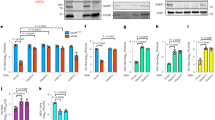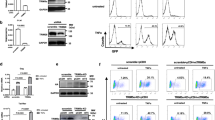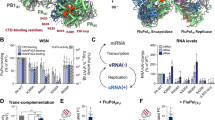Abstract
Type I interferon (IFN) stimulates transcription through a heteromeric transcription factor that contains tyrosine-phosphorylated STAT2. We show that STAT2 recruits histone acetyltransferases (HAT) through its transactivation domain, resulting in localized transient acetylation of histones. GCN5, but not p300/CBP or PCAF, is required for STAT2 function. However, GCN5 function is impaired by the transcriptional antagonist, adenovirus E1A oncoprotein. The TFIID component TAFII130 potentiates STAT2 function, but TAFII28 or the HAT activity of TAFII250 do not, and transcriptional induction can proceed independently of the TATA-binding protein, TBP. Moreover, IFN-stimulated transcription was resistant to poliovirus-targeted degradation by TBP, and continued despite host-cell transcriptional shutoff during poliovirus infection. We conclude that a non-classical transcriptional mechanism combats an anticellular action of poliovirus, through a TBP-free TAF-containing complex and GCN5.
This is a preview of subscription content, access via your institution
Access options
Subscribe to this journal
Receive 12 print issues and online access
$209.00 per year
only $17.42 per issue
Buy this article
- Purchase on Springer Link
- Instant access to full article PDF
Prices may be subject to local taxes which are calculated during checkout






Similar content being viewed by others
References
Levy, D. E. & Garcia-Sastre, A. The virus battles: IFN induction of the antiviral state and mechanisms of viral evasion. Cytokine Growth Factor Rev. 12, 143–156 (2001).
Darnell, J. E. STATs and gene regulation. Science 277, 1630–1635 (1997).
Veals, S. A. et al. Subunit of an α-interferon-responsive transcription factor is related to interferon regulatory factor and myb families of DNA-binding proteins. Mol. Cell. Biol. 12, 3315–3324 (1992).
Levy, D. E. Physiological significance of STAT proteins: investigations through gene disruption in vivo. Cell. Mol. Life Sci. 55, 1559–1567 (1999).
Qureshi, S. A., Leung, S., Kerr, I. M., Stark, G. R. & Darnell, J. E. Function of Stat2 protein in transcriptional activation by α-interferon. Mol. Cell. Biol. 16, 288–293 (1996).
Paulson, M. et al. Stat protein transactivation domains recruit p300/CBP through widely divergent sequences. J. Biol. Chem. 274, 25343–25349 (1999).
Park, C., Lecomte, M.-J. & Schindler, C. Murine Stat2 is uncharacteristically divergent. Nucl. Acids Res. 27, 4191–4199 (1999).
Bluyssen, H. A. R., Durbin, J. E. & Levy, D. E. ISGF3α p48, a specificity switch for IFN activated transcription factors. Cytokine Growth Factor Rev. 7, 11–17 (1996).
Bhattacharya, S. et al. Cooperation of Stat2 and p300/CBP in signalling induced by interferon-α. Nature 383, 344–347 (1996).
Xu, W., Edmondson, D. G. & Roth, S. Y. Mammalian GCN5 and P/CAF acetyltransferases have homologous amino-terminal domains important for recognition of nucleosomal substrates. Mol. Cell. Biol. 18, 5659–5669 (1998).
Agalioti, T. et al. Ordered recruitment of chromatin modifying and general transcription factors to the IFN-β promoter. Cell 103, 667–678 (2000).
Xu, W. et al. Loss of Gcn5l2 leads to increased apoptosis and mesodermal defects during mouse development. Nature Genet. 26, 229–232 (2000).
Martinez, E., Kundu, T. K., Fu, J. & Roeder, R. G. A human SPT3-TAFII31-GCN5-L acetylase complex distinct from transcription factor IID. J. Biol. Chem. 273, 23781–23785 (1998).
Wieczorek, E., Brand, M., Jacq, X. & Tora, L. Function of TAF(II)-containing complex without TBP in transcription by RNA polymerase II. Nature 393, 187–191 (1998).
Brand, M., Leurent, C., Mallouh, V., Tora, L. & Schultz, P. Three-dimensional structures of the TAFII-containing complexes TFIID and TFTC. Science 286, 2151–2153 (1999).
Reich, N., Pine, R., Levy, D. E. & Darnell, J. E. Transcription of interferon-stimulated genes is induced by adenovirus particles but is suppressed by E1A gene products. J. Virol. 62, 114–119 (1988).
Larner, A. C., Chaudhuri, A. & Darnell, J. E. Transcriptional induction by interferon. J. Biol. Chem. 261, 453–459 (1986).
Leung, S., Qureshi, S. A., Kerr, I. M., Darnell, J. E. & Stark, G. R. Role of STAT2 in the α-interferon signalling pathway. Mol. Cell. Biol. 15, 1312–1317 (1995).
Chakravarti, D. et al. A viral mechanism for inhibition of p300 and PCAF acetyltransferase activity. Cell 96, 393–403 (1999).
Look, D. C. et al. Direct suppression of Stat1 function during adenoviral infection. Immunity 9, 871–880 (1998).
Ogryzko, V. V. et al. Histone-like TAFs within the PCAF histone acetylase complex. Cell 94, 35–44 (1998).
Mengus, G., May, M., Carre, L., Chambon, P. & Davidson, I. Human TAF(II)135 potentiates transcriptional activation by the AF-2s of the retinoic acid, vitamin D3, and thyroid hormone receptors in mammalian cells. Genes Dev. 11, 1381–1395 (1997).
Floros, J., Ashihara, T. & Baserga, R. Characterization of ts13 cells a temperature-sensitive mutant of the G1 phase of the cell cycle. Cell Biol. Int. Rep. 259–269 (1978).
Dunphy, E. L., Johnson, T., Auerbach, S. S. & Wang, E. H. Requirement for TAF(II)250 acetyltransferase activity in cell cycle progression. Mol. Cell. Biol. 20, 1134–1139 (2000).
Wang, E. H., Zou, S. & Tjian, R. TAFII250-dependent transcription of cyclin A is directed by ATF activator proteins. Genes Dev. 11, 2658–2669 (1997).
Levy, D. E., Larner, A. C., Chaudhuri, A., Babiss, L. E. & Darnell, J. E. Interferon-stimulated transcription: Isolation of an inducible gene and identification of its regulatory region. Proc. Natl Acad. Sci. USA 83, 8929–8933 (1986).
Mirkovitch, J., Decker, T. & Darnell, J. E. Jr. Interferon induction of gene transcription analyzed by in vivo footprinting. Mol. Cell. Biol. 12, 1–9 (1992).
Bluyssen, H. A. R. et al. Structure, chromosome localization and regulation of expression of the interferon-regulated mouse Ifi54/Ifi56 gene family. Genomics 24, 137–148 (1994).
Baker, E., de Veer, M. J., Devenish R. J., Sutherland, G. R. & Ralph, S. J. Interferon- and virus-inducible gene ISG-60. Map position 10q23.3. Chromosome Res. 5, 572 (1997).
Strubin, M. & Struhl, K. Yeast and human TFIID with altered DNA-binding specificity for TATA elements. Cell 68, 721–30. (1992).
Guo, J., Hui, D. J., Merrick, W. C. & Sen, G. C. A new pathway of translational regulation mediated by eukaryotic initiation factor 3. EMBO J. 19, 6891–6899 (2000).
Yalamanchili, P., Harris, K., Wimmer, E. & Dasgupta, A. Inhibition of basal transcription by poliovirus: a virus- encoded protease (3Cpro) inhibits formation of TBP-TATA box complex in vitro. J. Virol. 70, 2922–2929 (1996).
Clark, M. E., Lieberman, P. M., Berk, A. J. & Dasgupta, A. Direct cleavage of human TATA-binding protein by poliovirus protease 3C in vivo and in vitro. Mol. Cell. Biol. 13, 1232–1237 (1993).
Liu, C. et al. MyoD-dependent induction during myoblast differentiation of p204, a protein also inducible by interferon. Mol. Cell. Biol. 20, 7024–7036 (2000).
Sadovsky, Y. et al. Transcriptional activators differ in their responses to overexpression of TATA-box-binding protein. Mol. Cell. Biol. 15, 1554–1563 (1995).
Crawford, N., Fire, A., Samuels, M., Sharp, P. A. & Baltimore, D. Inhibition of transcription factor activity by poliovirus. Cell 27, 555–561 (1981).
Dani, C. et al. Characterization of the transcription products of glyceraldehyde 3-phosphate-dehydrogenase gene in HeLa cells. Eur. J. Biochem. 145, 299–304 (1984).
Sonenberg, N. & Pelletier, J. Poliovirus translation: a paradigm for a novel initiation mechanism. Bioessays 11, 128–132 (1989).
Gustin, K. E. & Sarnow, P. Effects of poliovirus infection on nucleo-cytoplasmic trafficking and nuclear pore complex composition. EMBO J. 20, 240–249 (2001).
Iizuka, N., Chen, C., Yang, Q., Johannes, G. & Sarnow, P. Cap-independent translation and internal initiation of translation in eukaryotic cellular mRNA molecules. Curr. Top. Microbiol. Immunol. 203, 155–177 (1995).
Holcik, M., Sonenberg, N. & Korneluk, R. G. Internal ribosome initiation of translation and the control of cell death. Trends Genet. 16, 469–473 (2000).
Park, C., Li, S., Cha, E. & Schindler, C. Immune response in Stat2 knockout mice. Immunity 13, 795–804 (2000).
Yu, M. et al. Cloning of a gene (RIG-G) associated with retinoic acid-induced differentiation of acute promyelocytic leukemia cells and representing a new member of a family of interferon-stimulated genes. Proc. Natl Acad. Sci. USA 94, 7406–7411 (1997).
Zhang, J. J. et al. Two contact regions between Stat1 and CBP/p300 in interferon gamma signalling. Proc. Natl Acad. Sci. USA 93, 15092–15096 (1996).
Korzus, E. et al. Transcription factor-specific requirements for coactivators and their acetyltransferase functions. Science 279, 703–707 (1998).
Raval, A. et al. Transcriptional coactivator, CIITA, is an acetyltransferase that bypasses a promoter requirement for TAF(II)250. Mol. Cell 7, 105–115 (2001).
Beresford, G. W. & Boss, J. M. CIITA coordinates multiple histone acetylation modifications at the HLA- DRA promoter. Nature Immunol. 2, 652–657 (2001).
Bannister, A. J. & Kouzarides, T. The CBP co-activator is a histone acetyltransferase. Nature 384, 641–643 (1996).
Wathelet, M. G. et al. Virus infection induces the assembly of coordinately activated transcription factors on the IFN-β enhancer in vivo. Mol. Cell 1, 507–518 (1998).
Luo, R. X., Postigo, A. A. & Dean, D. C. Rb interacts with histone deacetylase to repress transcription. Cell 92, 463–473 (1998).
Acknowledgements
We thank Y. Nakatani, R. Schiltz, S. Roth, M. Rosenfeld, P. Sarnow, C. Basilico, M. Garabedian, M. Pagano, O. Silvennoinen, P. Lengyel, A. García-Sastre, G. Stark, and N. Hernandez for the kind gifts of antibodies, cell lines, virus, plasmids, and primers, and for helpful advice and discussions. We particularly thank K.Gustin for the gift of poliovirus, and W. Xu for providing GCN5 before publication. We thank I. Rogatsky for primer sequences for the collagenase I promoter, M. Pagano for the primers for p27Kip1, M. Wathelet and D. Dean for helpful advice on ChIP assays, and K. Murphy for helpful comments. C. P. was supported by a Medical Scientist Training Grant (5T32GM03708) from the National Institutes of Health. This work was supported in part by research grants from the NIH (AI28900, AI46503, AI48204) and the American Heart Association (9951033T).
Author information
Authors and Affiliations
Corresponding author
Supplementary information
Rights and permissions
About this article
Cite this article
Paulson, M., Press, C., Smith, E. et al. IFN-Stimulated transcription through a TBP-free acetyltransferase complex escapes viral shutoff. Nat Cell Biol 4, 140–147 (2002). https://doi.org/10.1038/ncb747
Received:
Revised:
Accepted:
Published:
Issue Date:
DOI: https://doi.org/10.1038/ncb747
This article is cited by
-
STAT proteins: a kaleidoscope of canonical and non-canonical functions in immunity and cancer
Journal of Hematology & Oncology (2021)
-
Transcription imparts architecture, function and logic to enhancer units
Nature Genetics (2020)
-
Differential roles of STAT1 and STAT2 in the sensitivity of JAK2V617F- vs. BCR-ABL-positive cells to interferon alpha
Journal of Hematology & Oncology (2019)
-
NOS1 inhibits the interferon response of cancer cells by S-nitrosylation of HDAC2
Journal of Experimental & Clinical Cancer Research (2019)
-
Decoding type I and III interferon signalling during viral infection
Nature Microbiology (2019)



